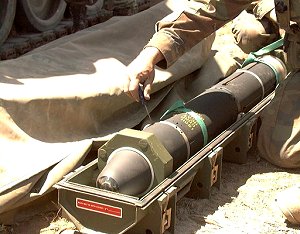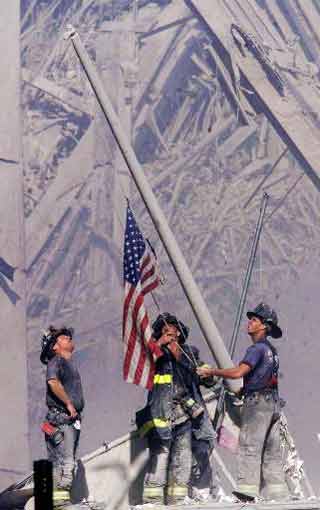Skip to comments.
The FReeper Foxhole's TreadHead Tuesday - M109 155mm SP Howitzer Series - Sep. 14th, 2004
www.globalsecurity.org ^
Posted on 09/13/2004 11:37:20 PM PDT by SAMWolf
click here to read article
Navigation: use the links below to view more comments.
first previous 1-20, 21-40, 41-60, 61-80, 81-94 next last
To: E.G.C.
Morning E.G.C. looks like it may be clear today.
21
posted on
09/14/2004 7:02:15 AM PDT
by
SAMWolf
(13 Witches in a hot tub - a self-cleaning coven!)
To: Professional Engineer
Good morning, PE!! Thank you for the Flag-o-gram.
Army Rabble Rousers- now that's a name I really like!
To: capocchio
Probably more than you wanted to know
The M712 Copperhead projectile was the first smart artillery round ever developed. Its accuracy is measured in centimeters, and its lethality is impressive. Copperhead is a cannon-launched, 155mm artillery projectile which guides itself to a laser-designated target. The munition is capable of defeating both armor and point targets at ranges of over six kilometers, and provides the battlefield commander with the unparalleled capability of utilizing artillery to the same effect as direct fire weapons and close air support. The system was employed during Operation Desert Storm, during which it met with great success. Copperhead projectiles were used to destroy observation and border guard posts and forward radar installations during the first week of artillery attacks.

The cannon-launched guided projectile (CLGP) M712 (Copperhead) is a 155-mm, separate-loading, laser-guided, HE projectile. It is heavier (137.6 pounds) and longer (54 inches) than the standard 155-mm projectile. The M712 projectile consists of three main sections: a guidance section (forward), warhead section (center), and control section (rear). The guidance section contains the seeker head assembly and the electronics assembly. The nose of the projectile houses a laser seeker in a plastic cone. The warhead section contains an HE antitank warhead consisting of 14.75 pounds of composition B. The control section includes the fins and wings that deploy in flight and allow the round limited maneuverability.
The trajectory of the Copperhead projectile is similar to that of a conventional round. Only when the projectile reaches a point on the descending branch of the trajectory does it differ. At that point, on the basis of the two-digit timer setting included in the fire commands, the guidance and control systems are activated. This enables the projectile to alter the remainder of its trajectory.

At 20 seconds from impact, the laser designator operator begins designating the target. The ground laser operator may use a G/VLLD, a laser target designator (LTD), or modular universal laser equipment (MULE). Airborne systems include the AH-64, OH-58D, and unmanned aerial vehicles. The Copperhead projectile acquires the reflected laser energy and initiates internal guidance and control, allowing it to maneuver to the target.
The ground surface area in which the round can maneuver is limited. The optimum limits of maneuverability of the Copperhead round is called a footprint. The size of the footprint is determined by the range and the shape of the trajectory, but it can also be affected by cloud height. The ballistic aimpoint is usually short of the target location sent by the laser designator operator. The distance that the ballistic aimpoint is short of the target location varies and is called the offset correction. This offset distance is used to ensure that the maximum probability of hit occurs at the original target location sent by the observer. The larger the target location error, the lower the probability of hitting the target.
23
posted on
09/14/2004 7:06:32 AM PDT
by
SAMWolf
(13 Witches in a hot tub - a self-cleaning coven!)
To: The Mayor
24
posted on
09/14/2004 7:07:15 AM PDT
by
SAMWolf
(13 Witches in a hot tub - a self-cleaning coven!)
To: manna
Hi Manna!

25
posted on
09/14/2004 7:07:41 AM PDT
by
SAMWolf
(13 Witches in a hot tub - a self-cleaning coven!)
To: Samwise
26
posted on
09/14/2004 7:09:38 AM PDT
by
SAMWolf
(13 Witches in a hot tub - a self-cleaning coven!)
To: bentfeather
Hi Feather. All dressed up for today. :-)
27
posted on
09/14/2004 7:10:07 AM PDT
by
SAMWolf
(13 Witches in a hot tub - a self-cleaning coven!)
To: Professional Engineer
Morning PE.
Congrats to the Rabble Rousers.
28
posted on
09/14/2004 7:11:01 AM PDT
by
SAMWolf
(13 Witches in a hot tub - a self-cleaning coven!)
To: Valin
1814 Francis Scott Key inspired to write "The Star-Spangled Banner" 
Gave proof through the night,
that our Flag was still there

29
posted on
09/14/2004 7:17:27 AM PDT
by
SAMWolf
(13 Witches in a hot tub - a self-cleaning coven!)
To: SAMWolf
Yupper, I'm getting better bout remembering to get my tank out!! LOL
To: 1stFreedom; Cannoneer No. 4; Redleg Duke; SAMWolf; archy; I got the rope; 300winmag; ...
FAMPL ping.
Freeper Foxhole Treadhead Tuesday, a look at the M109 series SP howitzer.
31
posted on
09/14/2004 7:22:12 AM PDT
by
Darksheare
(CBS: Arrogance and Hubris personified)
To: SAMWolf; capocchio
At picatinney Arsenal's on post museum, there's a section dedicated to Copperhead and it's predecessor.
From what the display said, copperhead was a reworked Naval artillery shell.
The Naval variant apparently did not go forward, leaving Copperhead as the sole dog left standing.
The Naval version had the fins folding the other direction, and from what I saw, that was the only difference.
32
posted on
09/14/2004 7:40:30 AM PDT
by
Darksheare
(CBS: Arrogance and Hubris personified)
To: snippy_about_it; All
GM, snippy!
i heard from duckie & "judyjudyjudy" for the last time until Saturday next about 1030 last night. the boat was about to sail.
can you believe it costs TEN DOLLARS a MINUTE to call to/from the ship and 80 cents a minute to email????
instead of emailing me, duckie will SHOP!
LOL.
free dixie,sw
33
posted on
09/14/2004 7:41:05 AM PDT
by
stand watie
(Resistance to tyrants is obedience to God. -T. Jefferson)
To: snippy_about_it; SAMWolf
Good morning, Foxhole! Falling in right on schedule for once.
Great unit patch, by the way .. may wind up wallpaper :)
Hope you are all doing well!
34
posted on
09/14/2004 7:44:50 AM PDT
by
Colonel_Flagg
(Someone needs to register CBS as a 527.)
To: SAMWolf
The Origins of the "American Attitude"
Major George Armistead, the commanding officer at Fort McHenry requested a flag "... so large that the British will have no difficulty in seeing it from a distance..." to be flown over the Fort. (You looking for me? I'm over here!!!)
On Sept. 13, 1814, Francis Scott Key visited the British fleet in Chesapeake Bay to secure the release of Dr. William Beanes, who had been captured after the burning of Washington, D.C. The release was secured, but Key was detained on ship overnight during the shelling of Fort McHenry, one of the forts defending Baltimore. In the morning, he was so delighted to see the American flag still flying over the fort that he began a poem to commemorate the occasion.
First published under the title "Defense of Fort M'Henry," the poem soon attained wide popularity as sung to the tune "To Anacreon in Heaven." The origin of this tune is obscure, but it may have been written by John Stafford Smith, a British composer born in 1750. "The Star-Spangled Banner" was officially made the National Anthem by Congress in 1931, although it already had been adopted as such by the Army and the Navy.
* "We opened up a big ol' can of whoop-ass on 'em."
* Yer Webmaster
"I pledge allegiance to the Flag of the United States of America,
and to the Republic for which it stands,
One Nation Under God,
indivisible, with liberty and justice for all."
* "Screw the 9th Circuit Appeals Court"
* Yer Webmaster
The Star Spangled Banner
O say, can you see, by the dawn's early light,
What so proudly we hail'd at the twilight's last gleaming?
Whose broad stripes and bright stars, thro' the perilous fight,
O'er the ramparts we watch'd, were so gallantly streaming?
And the rockets' red glare, the bombs bursting in air,
Gave proof thro' the night that our flag was still there.
O say, does that star-spangled banner yet wave
O'er the land of the free and the home of the brave?
On the shore dimly seen thro' the mists of the deep,
Where the foe's haughty host in dread silence reposes,
What is that which the breeze, o'er the towering steep,
As it fitfully blows, half conceals, half discloses?
Now it catches the gleam of the morning's first beam,
In full glory reflected, now shines on the stream:
'Tis the star-spangled banner: O, long may it wave
O'er the land of the free and the home of the brave!
And where is that band who so vauntingly swore
That the havoc of war and the battle's confusion,
A home and a country should leave us no more?
Their blood has wash'd out their foul footsteps' pollution.
No refuge could save the hireling and slave
From the terror of flight or the gloom of the grave:
And the star-spangled banner in triumph doth wave
O'er the land of the free and the home of the brave.
O thus be it ever when free-men shall stand
Between their lov'd home and the war's desolation;
Blest with vict'ry and peace, may the heav'n-rescued land
Praise the Pow'r that hath made and preserv'd us a nation!
Then conquer we must, when our cause it is just,
And this be our motto: "In God is our trust!"
And the star-spangled banner in triumph shall wave
O'er the land of the free and the home of the brave!
http://tsbolton.com/anthem.html
35
posted on
09/14/2004 8:00:25 AM PDT
by
Valin
(I'll try being nicer if you'll try being smarter.)
To: alfa6
Shoot and Scoot, always a good idea.:-)
36
posted on
09/14/2004 8:01:13 AM PDT
by
snippy_about_it
(Fall in --> The FReeper Foxhole. America's History. America's Soul.)
To: stand watie
Think of ALL the money she'll save you.
Do I really need a sarcasm tag?
37
posted on
09/14/2004 8:02:43 AM PDT
by
Valin
(I'll try being nicer if you'll try being smarter.)
To: SLB
..although this was for a REFORGER For Dan Rather? LOL. Sorry, couldn't resist.
Thank you for your service SLB.
38
posted on
09/14/2004 8:04:43 AM PDT
by
snippy_about_it
(Fall in --> The FReeper Foxhole. America's History. America's Soul.)
To: E.G.C.
39
posted on
09/14/2004 8:05:13 AM PDT
by
snippy_about_it
(Fall in --> The FReeper Foxhole. America's History. America's Soul.)
To: capocchio
Welcome to the Foxhole capocchio. Be sure and tell your brother we appreciate his service and pray he stays safe.
40
posted on
09/14/2004 8:07:42 AM PDT
by
snippy_about_it
(Fall in --> The FReeper Foxhole. America's History. America's Soul.)
Navigation: use the links below to view more comments.
first previous 1-20, 21-40, 41-60, 61-80, 81-94 next last
Disclaimer:
Opinions posted on Free Republic are those of the individual
posters and do not necessarily represent the opinion of Free Republic or its
management. All materials posted herein are protected by copyright law and the
exemption for fair use of copyrighted works.
FreeRepublic.com is powered by software copyright 2000-2008 John Robinson




